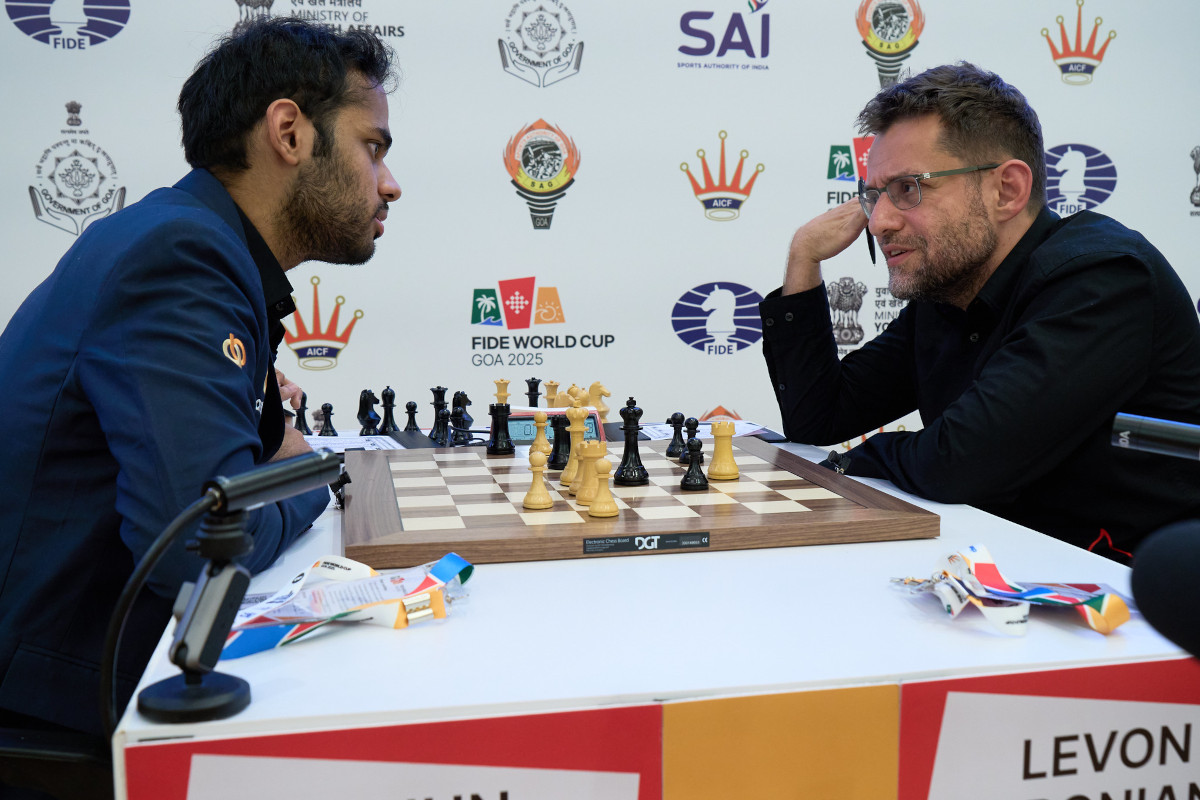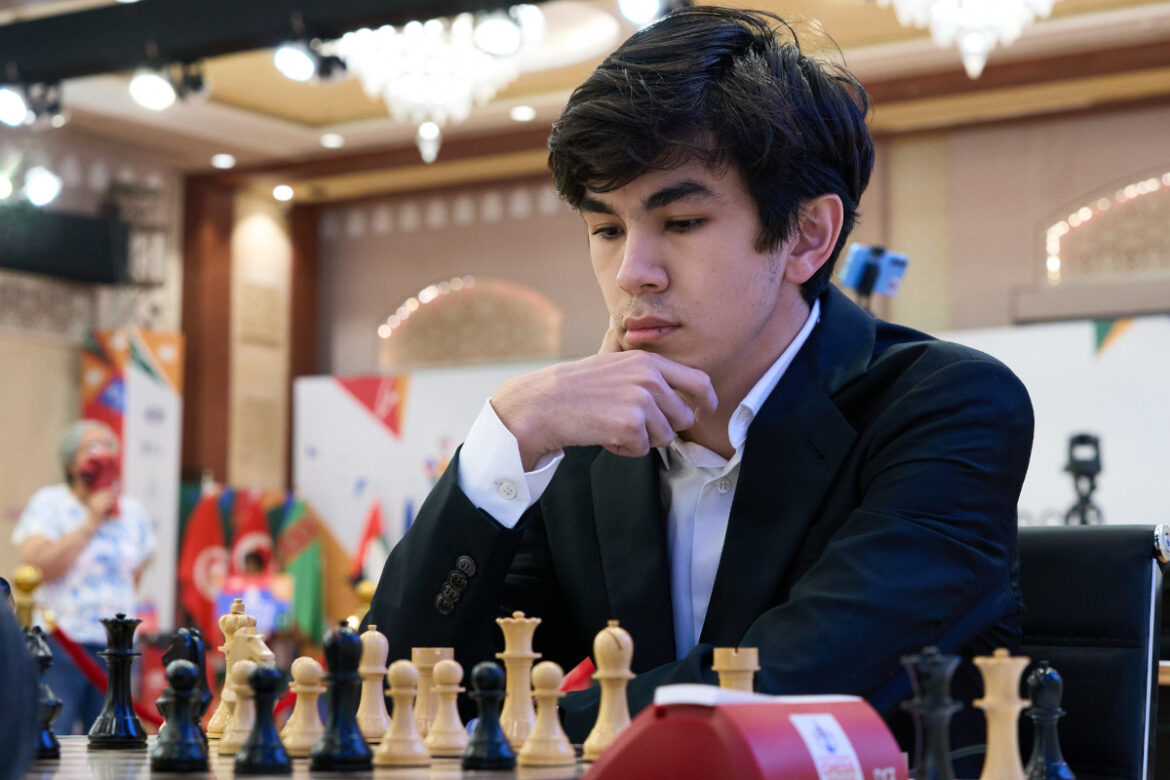Sindarov the only winner of the day
The round-of-16 began on Friday in Goa at the FIDE World Cup and, for a while, it appeared entirely plausible that all eight games would end in draws. Three encounters, however, offered winning chances for one of the sides, yet only one match ultimately produced a decisive result. The winner of the day was 19-year-old Uzbek GM Javokhir Sindarov, who defeated Germany’s Frederik Svane with the white pieces.
Although no other player managed to convert their pressure, both Arjun Erigaisi and Daniil Dubov came closest. Erigaisi put Levon Aronian under sustained pressure, and Dubov did the same against Sam Shankland, but resourceful defence in both cases ensured they reached Saturday’s second classical game level at ½–½.
In today’s fast-paced chess world, especially online, where blitz and rapid games dominate, the traditional approach of grinding through lines of opening theory can feel overwhelming, and even unnecessary. The real challenge? Striking the right balance in your opening preparation. How deep should you go? Where do you stop? This course is built on the timeless wisdom of my legendary coach, Chebanenko, who designed opening repertoires for his “lazy” students – not lazy in attitude, but smart in approach. His philosophy? Don’t memorise. Understand.

Andrey Esipenko going through the medal detector control | Photo: Eteri Kublashvili
Sindarov’s win arose from yet another Italian Opening, a line that has become particularly prominent in this year’s knockout event. The Uzbek rising star gained the upper hand in the middlegame, gradually increasing his control of the position. Svane, who entered the roundafter impressive upset victories over world champion Gukesh Dommaraju and Shant Sargsyan, defended tenaciously. He sacrificed a pawn to generate activity and maintained drawing chances for a considerable stretch, fully aware that even a small inaccuracy could tip the balance against him.
The game eventually clarified into an endgame in which Sindarov held the pair of bishops against Svane’s bishop and knight. Converting the advantage required precise calculation, especially as Sindarov allowed – correctly – the German grandmaster to create a passed pawn on the a-file. The white pieces maintained control, however, and after a long resistance, Svane resigned on move 68. He will thus be the only player entering Saturday’s second game needing a win to stay in the event.
Sindarov, seeded 16th in Goa, has been rising steadily through the international ranks. He has remained above 2700 Elo since February and is part of Uzbekistan’s exceptionally strong new generation. Alongside the two Nodirbeks – Abdusattorov and Yakubboev – he has been central to the country’s recent success on the world stage. Abdusattorov was eliminated by Jose Martinez in round three, but Yakubboev remains in contention and safely held a 32-move draw with black against Gabriel Sargissian on Friday.
Sindarov 1-0 Svane
Analysis by GM Karsten Müller
In this insightful video course, Grandmaster David Navara shares practical advice on when to calculate deeply in a position — and just as importantly, when not to.
Free sample video: Introduction
Free sample video: Invisible moves

The one game that ended decisively at the start of round five | Photo: Eteri Kublashvili
Shankland ½-½ Dubov
If one skill decides more games, it’s calculation. Openings fade, plans change – but seeing clearly, comparing lines, and choosing with confidence wins points. In this course GM Ganguly turns calculation into a trainable skill with a structured path for any level. You won’t just solve tactics; you’ll learn how to think: where to start, which branches to explore, when to stop, and how to keep a crystal-clear mental board under pressure.
Free video sample: Introduction
Free video sample: Forcing moves

The ever-ambitious Sam Shankland | Photo: Eteri Kublashvili
Erigaisi ½-½ Aronian
Analysis by GM Karsten Müller
Picture this: you’ve outplayed your opponent move by move, you’re clearly better – and then the endgame slips into a draw, simply because you lacked the crucial theoretical knowledge. That is exactly where this course comes in. Without solid endgame skills, there’s no way forward. Rook endgames are most essential: they occur more often than any other type of endgame, and often make the difference between victory and half a point. If you master them, you’ll confidently convert your advantages into wins!
Free video sample: Introduction
Free video sample: Bodycheck

Arjun Erigaisi and Levon Aronian | Photo: Eteri Kublashvili
All games – Round 5
Replay games from all rounds at Live.ChessBase.com
EXPAND YOUR CHESS HORIZONS
Data, plans, practice – the new Opening Report In ChessBase there are always attempts to show the typical plans of an opening variation. In the age of engines, chess is much more concrete than previously thought. But amateurs in particular love openings with clear plans, see the London System. In ChessBase ’26, three functions deal with the display of plans. The new opening report examines which piece moves or pawn advances are significant for each important variation. In the reference search you can now see on the board where the pieces usually go. If you start the new Monte Carlo analysis, the board also shows the most common figure paths.
